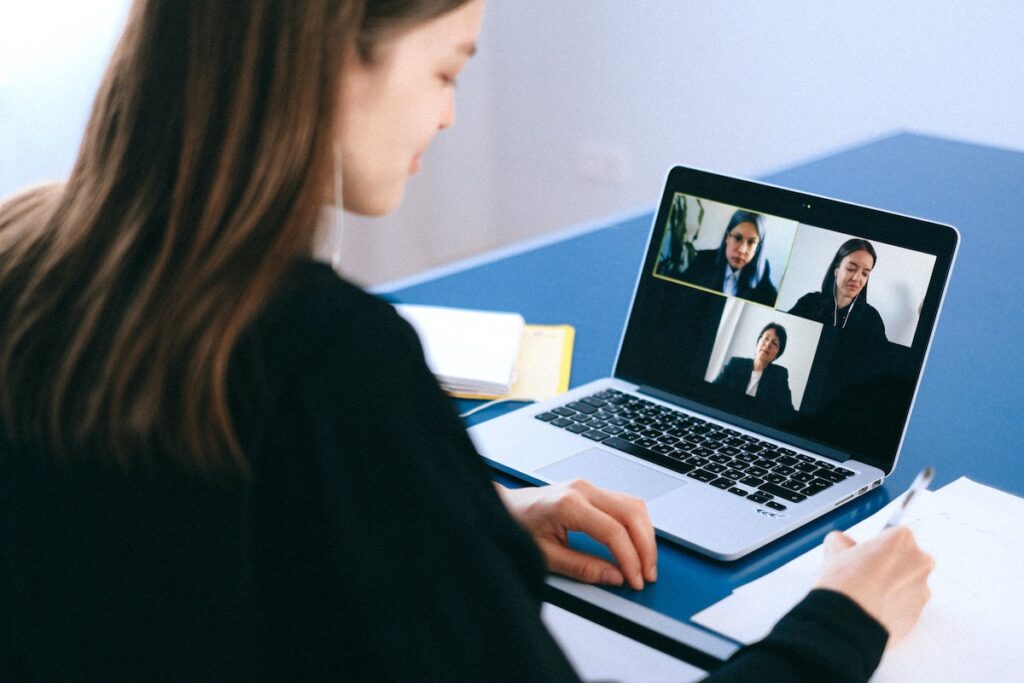How to ease communication-related anxiety while working remotely
Whilst some businesses are beginning to return to office working, for many professionals and organisations, remote working is likely to remain an integrated part of corporate life, whether full time or for a few days a week.

Adapting to the new normal, professionals at all levels of business are being met with new remote communications challenges. RADA Business, the commercial subsidiary of the Royal Academy of Dramatic Art, reveals it has received a significant increase in leaders seeking professional guidance since the start of lockdown wishing to improve their communication skills via virtual mediums and tackle anxieties related to remote working.
Speaking to Life Coach Directory, RADA Business tutor, Kate Montague, shares her insights to help professionals ease communication-related anxiety whilst working from home.
Why do you think more of us are struggling with work-related anxiety while working remotely?
There are myriad reasons why remote working can take its toll. We are creatures of habit and anything that causes us to venture into the unknown can trigger our ‘fight or flight response’, or a sense of feeling threatened or overwhelmed, and this is bound to have an impact on how we think, feel, breathe and express ourselves.
Remote working means we are no longer surrounded by our usual support network of colleagues who have our backs and step in to help where needed; perhaps we’re struggling to get our hard work recognised, or the boss is constantly questioning our outputs whilst we’re at home and away from their watchful eye. And of course, with remote working, comes specific tech problems.
Difficult communication is one of the biggest causes of remote work-related anxiety, but once we understand this we can then begin to take steps to consider our interaction with others and improve our communication.

What can we do to manage work-related anxiety while working remotely?
Solid communication is pivotal in tackling remote working anxieties. A phone or video call is always going to be a clearer and more efficient method of communication than batting emails back and forth, or using multiple social messaging apps.
Setting aside time to have regular catch-ups with your team or clients can reduce the risk of miscommunications online and, as the saying goes, “a problem shared is a problem halved”. So often the act of talking through issues with someone else can help us to relax and declutter the mind.
At RADA Business we provide coaching on communications, but we also look at where stress is manifesting itself. Often, it takes a physical form in the spine and in our posture. When anxiety is particularly high, physical exercises and stretches can also help to relieve work-related anxiety.
Stretching upward to lengthen the spine, rolling out the shoulders, and gently releasing your neck, are a few simple and effective exercises we can do at home, between virtual calls, to release physical tension. It is a good idea to do this from standing so that you reclaim your body’s natural alignment, which will inevitably be compromised from too much sitting.
It takes 3-5 minutes of conscious breathing to reset the nervous system, calming the ‘fight or flight response’, helping to make us more comfortable both physically and mentally. To do this, take a moment to sit or stand tall, then allow yourself to become aware of your breath and breathe deeply and fully, in through the nose, releasing out through the mouth. Let yourself breathe up and down your body. Aim to breathe consciously, and more deeply than normal at periods throughout the day, particularly during stressful spells, to help relieve anxiety and clear the mind. This will help enable you to respond to situations rationally and empathetically rather than letting your emotions drive you.

What tips do you have for keeping communication smooth and productive when working remotely for both leaders and members within a team?
When using visual platforms, taking time to find a reliable video conferencing service can keep meetings efficient by reducing time lost to technical difficulties. Getting set up with a good camera and microphone helps us to land messages clearly. Be practical – check that you can be seen clearly – lighting from the front really helps.
Sitting with a window behind you, for example, will mean that you are seen only in silhouette. Headsets are useful for clarity and privacy in your own quiet zone, yet ensure that your headset is discrete and does not detract from your presence.
Temperamental video conferencing software and poor wi-fi connections can cause further communications issues, so be sure to check in with whomever you are speaking with and have them confirm that they’ve understood the points you are making. This will ensure your message has been received and has landed as you intended.
Create intimacy and connection through setting an appropriate tone with your listener. You can do this by connecting to a strong intention for each meeting: my intention, for example, is to help, or to mentor, or to support, or be flexible.
Speaking clearly on video calls is hugely helpful and it’s not just a wi-fi signal that can hinder this. Consider your posture: make sure you’re lengthening through the spine, and think of your pelvis as a foundation stone to your spine – let it relax into the base of the chair. Be sure to ground yourself with your feet flat on the floor, too, as this will help you to connect your breath to your speech so you’re able to communicate comfortably with depth of tone and clarity.

Do you think the pandemic has paved the way for more compassionate leadership at work?
During these challenging past few months, business leaders have seen how resilient they can be. In this Covid-era, we’re seeing an increased need to acknowledge strengths.
Simultaneously there is more willingness to acknowledge vulnerability at more senior levels. This is key as it develops our empathy and leads to deeper human connections – the bottom line of any business – and crucial for effective leadership.
Leaders who are willing to lead by example, and practise self-care and compassion are in a far better position to be more compassionate toward those working beneath them, and in turn will create an atmosphere where people feel freer to express themselves, more fully, including their vulnerability, rather than creating a culture of suppressed feelings and a lack of transparency.
As leaders, the relationship we have with our team is everything. Online and remote communication can only benefit from prioritising compassion. Rapport and intimacy become even more important if a team is downsized or colleagues are struggling with their own remote working anxieties.
In recent months, we’ve seen leaders adopting more regular check-ins to ensure their team’s workload is relatively balanced to prevent exhaustion and burnout amongst the ranks. Teams thrive on celebrating the wins, so we also encourage leaders to factor in time to thank the team in some way, either verbally or with small tokens of appreciation.
Whilst surviving the recent months have been stressful for us all, they have also helped us to learn about balance and to become more attuned to what we need in order to thrive, including how to be more responsive to our colleagues and clients, and maintain a relaxed and expressive connection within online forums.

Find a coach dealing with Career coaching
All coaches are verified professionals





